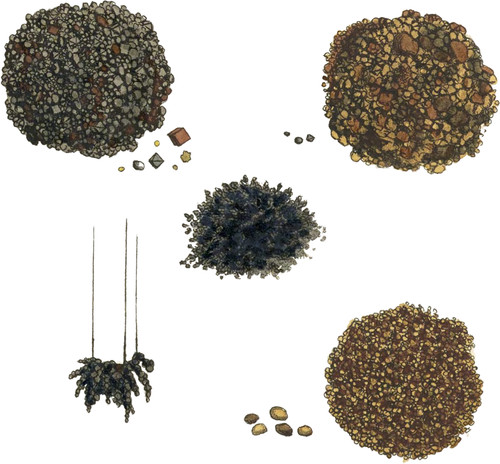 Enlarge
Enlarge
British Mineralogy
Suboxide of Iron. Magnetic Iron Ore
- Div. 3. Amorphous, in Grains.
A few years since, the Rev. Dr. Charles Sutton sent me, among other natural curiosities, some sand from Hunstanton, in Norfolk, of a blackish appearance. Not being at that time engaged in mineralogical pursuits, I laid it by; but when I was about to begin this work, he kindly brought me some more, which was still blacker. On looking attentively at it, I thought attractive iron might be the cause of its blackness, and soon found it to be the case, and that some of the sand might be rendered magnetical, the particles clinging together after being detached from the magnet. I considered it as a great curiosity, particularly as I had no where seen mention made of such sand, excepting from America, and requested to have more, at the same time speaking of its qualities; which request was kindly attended to. Shortly after, I received a note informing me that what had since been found was not attractible, and the same was observed by some other friends, who attempted to procure me some from other places. I examined the sand to discover the natural cause for this, and found it was not so black, and that there was little or no attractible iron; only some brown ochraceous particles, like Bog Iron Ore. It might have become oxidated by the weather: thus there is a season to find it in perfection, which should be attended to; and if it proves useful, it may, no doubt, be had in great abundance, being found in many places near the coast. Some was found in very common-looking sand sent me from Scarborough by my friend Dr. Travis, since which I have had the pleasure of receiving Iron Sand from Wicklow in Ireland, by favour of Dr. Scott. In examining this it evidently betrayed its habitat by minute particles of gold, besides which it has Octaëdral Iron more or less oxidated, and some Cubic Pyrites, Pebbles, &c.
Again, in July last, my valued friend James Brodie, Esq. sent me some beautiful Arena ponderosa, as it was called, sent by Governor Stewart of Fort St. George from the Ferry of Ardentenny in Argyl shire, where, the governor observes, it is found in the greatest abundance, washed out of the banks by the sea 5 and what was sent me was as pure as that separated from the others, and somewhat brighter, with octaëdral crystals, small, black, abundant, and very attractible.
The right-hand upper figure is of the pebbles and sand from Hunstanton in a heap, and I he particles of iron of the size generally found, by the side. The figure underneath is such as is found when the sea has washed it and oxidated it. The five pebbles on the side magnified are three common Quartz pebbles, which compose common sand, and two darker, chiefly Oxide of Iron. The left-hand upper figure is the Irish Sand, and the figures on the side show the Octaëdron, Cube, Gold, and Pyrites. Beneath is the outline of a magnet, and the Iron in common as attracted by it at the base. The middle figure is a parcel like that from Scotland, or such as has been separated from the other sands.
Thus it appears that this sort of Sand, which was hitherto supposed to be found only in America, has now been found in England, Scotland, and Ireland, or the three grand divisions of the British empire. I should think these might be of great use to the proprietors, if properly attended to. I understand Ardentenny is the property of Lord Dunmore.

